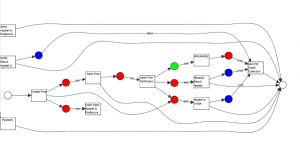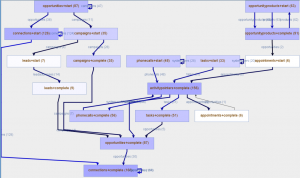Archive for November, 2018
Prevention of “Melting Clocks” by Process Mining!
This post is by Elham Saberi, Scientific Assistant in the Process And Data Science group at RWTH Aachen University. Contact her via email for further inquiries.

Salvador Dalí, The Persistence of Memory, 1931. From Wikipedia
Process Mining studies the flow of work in an automated business process, from an initial to the final point, in order to find bottlenecks and parts in which time and money can be saved or processes can run more systematically and efficiently.
Conformance analysis, which is an essential procedure within process mining, represents how much the behavior described by a process model is in line with the behavior that is captured in an event log; additionally, performance analysis how much time is consumed in different parts of the executions. In particular, this type of analyses is useful to identify bottlenecks that are situations where the process execution slows down or in the worst case it is blocked.
“Time is Gold” so let’s get rid of bottlenecks!
Performance analysis is useful to detect bottlenecks or parts of process that are repeated several times and that leads to a longer trace execution.
When we deal with “real data”, we face with some common questions such as: How long does it take to execute a particular transition? Where are the “time holes” in the process? What are the necessary actions to speed up the process?
One of the ways to speed up the process is to change our global viewpoint to a more local and specific view that enables us to consider one individual place (with its pre-sets and post-sets) and concentrate on its behavior.
Global vs Local view – “Small is Beautiful” so think globally act locally!
There are numerous analysis tools (beside human brain!) which are perfect in doing local analysis, while global analysis generally provides less detailed information. That means, we have to compromise global and local analysis in order to have a balanced view on both. Local analysis, anyhow, is faster, to-the-point, with power to provide detailed diagnoses.
During a pilot research work at PADS RWTH a novel method was developed to align an event log and a Petri net containing visible unique transitions. This method provides a localized analysis by focusing on places in a process model. The method is faster in comparison to classic Conformance and Performance Analysis techniques like alignment-based and token-based replay; we called this new method IC-pairing alignment (IC stands for token Insertion and token Consumption).
In this localised analysis we deal with three scenarios: a place can be “fitting” (green places), “underfed” (blue places), or “overfed” (red places).

Colour-coded Petri net resulted from an IC-pairing alignment, which supports localized analysis.
This new type of alignment gives advantages to support process analysis more effectively, by detecting the lost time in process loops and the periods in the time interval in which the process has been most efficient (avoiding for example the re-opening of the whole process or the execution of additional activities). In addition, it is able to detect which constraints (places) in the process have problems, enabling the usage of repair techniques to improve the process model and making it more conform to the reality.
StarStar models: extract a process representation from databases without the need of a case notion
This post is by Alessandro Berti, Software Engineer in the Process And Data Science group at RWTH Aachen University. Contact him via email for further inquiries.

Comparison between classical ETL scenario (left) and ETL scenario with StarStar models (right).
In process mining projects, a vast amount of time is spent on the ETL phase, which is related to the extraction of the event logs and the process models. Process models can be discovered from event logs by applying a classic Process Mining technique (like the Inductive Miner). An event log is organized in cases and events, where a case groups events that are related to the same instance of the process. However, obtaining an event log from a database is a tricky process and requires the specification of a case notion, so a set of attributes/columns that group the events into cases. Specifying a case notion is often non-trivial:
- It requires a deep knowledge of the process(es) saved in the database
- It often requires to join several entities, making the extraction slow
Without expertise from both process and IT worlds, it seems difficult to extract an event log from a database. In the last years, some research has been done in order to simplify the extraction process, and we can cite some papers:
- Calvanese, Diego, et al. “Ontology-driven extraction of event logs from relational databases.” International Conference on Business Process Management. Springer, Cham, 2015. In this paper, a way to translate SPARQL queries, that are easier to express, into SQL queries is provided.
- Li, Guangming, Renata Medeiros de Carvalho, and Wil MP van der Aalst. “Automatic discovery of object-centric behavioral constraint models.” International Conference on Business Information Systems. Springer, Cham, 2017. In this paper, a modeling technique on-top of databases is presented, that is able to discover some interesting patterns for conformance checking application.
- de Murillas, Eduardo Gonzalez Lopez, et al. “Audit Trails in OpenSLEX: Paving the Road for Process Mining in Healthcare.” International Conference on Information Technology in Bio-and Medical Informatics. Springer, Cham, 2017. In this paper, a meta-model where database events can be inserted is presented. This meta-model could be queried using SQL language and the complexity of event log retrieval is decreased.
The PADS team developed StarStar models, that are a novel way to represent event data on top of relational databases. The main view provided by StarStar models is the A2A (activities) multigraph, in which activities can be connected by several edges.

A2A multigraph of the StarStar model extracted from a Dynamics CRM installation.
An edge in the A2A multigraph is associated to a class perspective, and is inferred observing directly-follows relationships between events in the perspective of some object belonging to the given class. StarStar models provide also a drill-down functionality where, given a class perspective, a classic event log to use with mainstream process mining techniques can be obtained.
Classic event logs and process models can be obtained through drill-down in a StarStar model.
StarStar models seems to be very promising for process visualization, since the edge can be annotated by the frequency or the performance (along with the class perspective for which the edge was detected).

